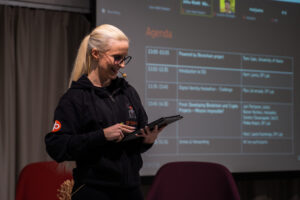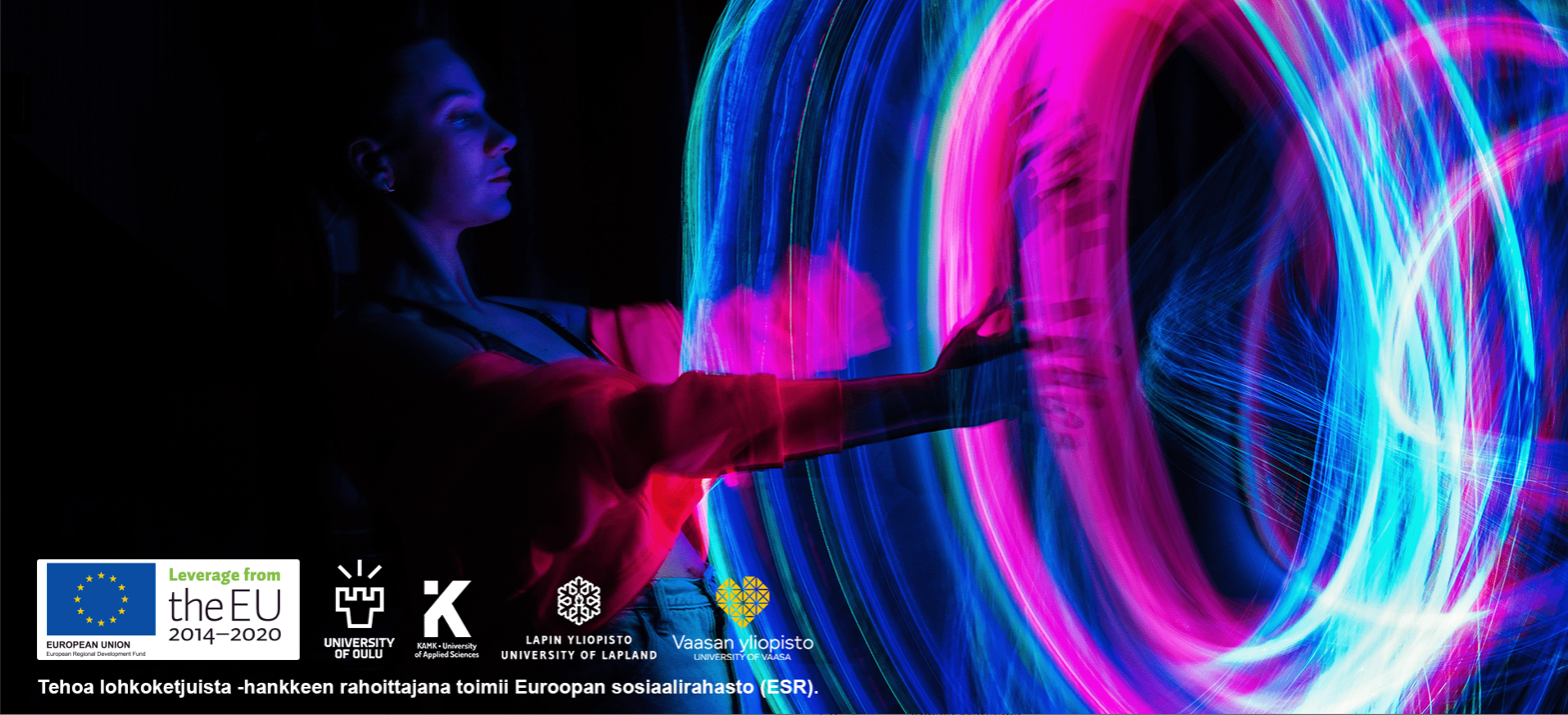
Most well-known use cases of blockchain technology are cryptocurrencies. Nevertheless, the foundational technology enabling the cryptocurrencies, provides excellent opportunities way beyond. The most important features of blockchain are its’s cyber security features, enabled by authenticity, transparency, immutable ledgers and the lack of a single point of failure.
Powered by Blockchain-project
Powered by Blockchain-project is a collaboration project between University of Vaasa, University of Oulu, University of Lapland and University of Applied Sciences Kajaani. Project is funded by European Social Fund. The project seminar and hackathon kickoff was arranged in Oulu 10.2.2023.
Project started at May 2020 with target to increase knowledge on blockchain and build education. During the past years, the project consortium has develop six new training modules concentrating in blockchain. In addition to courses, project arranged seminar and Hackathon in collaboration with OP Lab.
University of Vaasa’s Digital Economy research platform has been proud member of project consortium, and was responsible for arrangements of seminar day. The seminar was a captivating event that brought together universities, blockchain experts, developers, and enthusiasts to discuss the latest trends, developments, and future of blockchain technology. Blockchain technology has been gaining momentum over the years, and it’s transforming various industries, including finance, healthcare, real estate, and supply chain management. This transformation is not necessary the most visible phenomena yet on these industries, nevertheless there is a lot going on under the hood. Sooner or later the foundational work will become visible to larger audiences.
We are witnessing more and more effort also from policymakers to understand the potential benefits of blockchain. For example excellent report from the European Commission JRC research organization: “Blockchain solutions for the energy transition, Experimental evidence and policy recommendations” https://publications.jrc.ec.europa.eu/repository/handle/JRC128651
Seminar
At the seminar, we had the opportunity to learn from some of the brightest minds in the blockchain industry who shared their knowledge, experiences, and insights on the technology’s potential and challenges. Experts from academia and technology leaders from companies such as Superhow?, Chainlink, Joisto, Interjektio, Q4us and op-lab shared their knowledge on the blockchain business and technology.
The general fallacy on the theme appears still to be, that Blockchain equals Bitcoin, or other cryptocurrency. We all can agree, that still most well-known use cases of blockchain technology are cryptocurrencies. Nevertheless, blockchain technology is only enabling the use case of cryptocurrencies, the technology itself provides opportunities way beyond this one specific use case.
Blockchain is a disruptive technology in many ways, meaning it will change the current business status quo’s by reducing intermediaries, replacing current business models, creating and enabling new ones. Even as project coordinator, time to time I notice myself doubting the visions of blockchain. Nevertheless, after gathering more knowledge on the theme, the transformation seems undoubted. The main question appears to be about the timeline of the transformation, not if the transformation will actually happen or not.
The current topics and thoughts on blockchain reminds me of Slush 2016, where I was a visitor. In the event, I remember listening panel discussion about AI and music, the panel’s main was how AI will be able to produce music in the future. As a hobby musician, I remember thinking back then in 2016, that this conversation is total utopia. How in the earth could AI be capable of such a complex process, as music creation, and in a level which is acceptable to human ears. Back then, I never believed it would become reality. Today in 2023, we see tools like https://soundful.com/, which actually is capable of producing electronic music, and which is almost impossible to distinguish from human electronic music producers work by non-professionals. Technology is amazing and constantly changing the world, and this is just one brief example. We will see how the upcoming years will treat blockchain.
Aušrinė Šilenskytė, Researcher Uwasa – Approaching blockchain adoption strategically
Seminar was started with University of Vaasa’s Aušrinė Šilenskytė presentation about Approaching blockchain adoption strategically. Aušrinė have researched the topic from various angles and presented these views to audience. Based on her research, there are many early adopters who have failed in adoption of blockchain, nevertheless also many success stories have risen and technology is constantly becoming more mature.
The speaker discusses the adoption of blockchain technology in the corporate environment, emphasizing the importance of first determining whether a company really needs it by assessing the kind of transactions it has. Industries with repeated transactions involving many different stakeholders may benefit from blockchain, such as insurance and supply chain operations. The speaker notes the importance of determining whether a company needs a firm-level or industry-level solution.
The social elements of blockchain adoption are also critical to consider, as blockchain technology is not just the technology itself, but also the social structures involved. The speaker cites the example of TradeLens, which failed due to underestimated social structures, such as trust and access to data. The speaker stresses the importance of understanding the differences between different blockchain types, such as centralized, semi-centralized, and fully decentralized, and the potential social implications of using them. Blockchain is not general solution to everything, but a very good solution to well defined specific challenges.
Blockchain-based businesses can survive and succeed by adopting good ethical principles and values and carefully choose technical approach. The author notes that while it is possible to create public blockchain-based businesses without legal entities (DAO-based), having a legal entity to raise funds, manage team accountability and other activities is necessary to manage daily operations.
The speaker identifies four tactics for businesses to survive in the face of legal uncertainty and practice uncertainty: avoid window dressing, respect the jurisdiction arbitrage and legitimization efforts, and accept the power of institutions. In this context, “window dressing” means giving the appearance of adhering to legal and ethical principles without actually doing so. It refers to superficial or cosmetic changes made to the business practices or company structure to create a positive image, rather than implementing substantive changes, that align with legal and ethical principles. Aušrinė suggests that while “window dressing” might provide a short-term solution for a company, it is not a reliable long-term strategy for survival. Blockchain is a technology beyond borders and existing regulatory frameworks, and policies and policy makers should reflect this.
Andrius Bartminas, Co-founder and CEO at SUPERHOW – Blockchain revolution in Lithuania
Our seminar’s next presenter was Andrius Bartminas, Co-founder and CEO at SUPERHOW. SUPERHOW is a visionary research and development company committed to harnessing the power of blockchain for the advancement of society with next-generation solutions. Superhow’s team has grown to become Lithuania’s leading private research and development lab focusing on DARQ technologies. In 2022 SUPER HOW? was recognized as the “Fintech Innovator of the Year” in the Lithuanian Fintech Awards. The company is one of the founders of the Blockchain Lithuania Competence Center. Andrius presented well established overview of history of blockchain revolution in Lithuania and interesting use cases.
The speaker discussed how blockchain technology started in Lithuania and became a booming business in 2017 and 2018, during the ICO period. Lithuanian companies raised half a billion euros in initial coin offerings, making Lithuania the 8th country in the world with the most attracted money in the ICO field. However, this period also led to legal issues as it attracted attention from law and order, and the Bank of Lithuania’s Ministry of Finances regulated ICOs. Associations and organizations were established to gather people interested in blockchain and cryptocurrency in the country. Finally, the speaker mentioned that cooperation was important to make Lithuania a blockchain competence center in Europe, which was the goal and aim in 2018.
Andrius is also discussing a project called Axiology (www.axiology.xyz), which is a blockchain infrastructure consortium designed to automate the securities, transactions, and trading of securities in a decentralized finance model. A key feature of Axiology is that it can tokenize securities, have money on the same layer, and measure impact investments such as social scores and carbon credits. The article states that with this project, atomic transactions and instant settlement can be achieved. https://hifi.finance/ is a company that has synergies with Axiology, which enables the marketplace to integrate exchanges and brokers to enable the funding of green and sustainable projects. The blockchain is used to tokenize agreements and intellectual property, which is a radical idea in the market. Andrius is discussing the idea of Real Time Economy and how it enables second-based salaries and content creators to receive direct payment, without intermediates.
Superhow is has well established connections to EU and based on Andrius’s presentation, the EU regulators are recognizing more and more the potential benefits of decentralized finance and blockchain technology, as new opportunities for financial institutions to work with crypto assets and tokenize fiat currencies are being created. This is due to new regulations and exemptions which allow for the creation of distributed ledger technology (DLT) based solutions for securities and financial markets. This has also given rise to the concept of ultimate ownership, where data, technology, and anything else can belong to individuals rather than corporations. While startups working in this space face hurdles, the innovative environment is still attractive due to the potential benefits that can be created. The use of smart contracts can reduce the risks involved in centralized finance, providing transparency and privacy, as well as the democratization of the internet.
During the conversation, Andrius’s expert opinion was asked about the biggest opportunities and challenges for blockchain adoption in the corporate world. Andrius explained that the biggest challenge for established businesses is approaching blockchain as a technology to use for their current business model as another database, rather than thinking about the technology first and building on its opportunities, limitations and functionalities. Andrius stresses that the blockchain is not just another database and it comes with different requirements, such as the need for private and public keys, which may be a big gap in user expectations and opportunities. Andrius suggest that companies need to be willing to rethink their business models when adopting blockchain, and frustration arises when this is not acknowledged and only assumed that “blockchain is just another database”.
Earlier Aušrinė Šilenskytė referred to same subject by describing a superficial or cosmetic changes made to the business practices or company structure to create a positive image, rather than implementing substantive changes, that align with legal and ethical principles and which is supported by technology. Blockchain enables new ways of doing business and depending on the established corporations’ approach, this can be even thread or opportunity.
Adrej Rakic, developer advocate Chainlink- Building a Web3 World Powered by Cryptographic Truth
We had honor to have chainlink’s (https://chain.link/) developer advocate Adrej Rakic as speaker in our seminar. Chainlink is a decentralized oracle network that connects smart contracts on blockchain platforms with off-chain data sources and APIs. In simpler terms, it provides a way for blockchain applications to securely and reliably access data from outside the blockchain ecosystem.
This is important because smart contracts on blockchains are self-executing programs that rely on inputs to trigger actions. Chainlink’s network provides a way to securely bring in data from real-world sources, such as market data, weather reports, and sports scores, so that smart contracts can execute based on that data. Chainlink achieves this through a decentralized network of node operators that retrieve and verify data from off-chain sources, and then send that data back to the requesting smart contract on the blockchain. Node operators are incentivized with the LINK token, which is used to pay for data requests and secure the network. Overall, Chainlink aims to enable more advanced and complex smart contract applications, by providing a reliable and secure way to access off-chain data. (https://chain.link).
Andrej presented how smart contracts solve the problem of trust, by allowing for immutable digital agreements on a blockchain that are transparent and public. However, smart contracts are isolated and cannot access off-chain data, which creates the smart contract connectivity problem. Chainlink protocol is a middleware layer on top of blockchains that can provide off-chain data and computation to any given general purpose blockchain. It does this through a decentralized oracle network, consisting of nodes that reach a consensus to provide accurate and secure data to smart contracts. Chainlink focuses on decentralization to prevent centralized oracles from being a point of failure.
Andrej features of three chainlink products. The first product is data feeds, which provide information about the prices of tokens, NFTs, and other relevant data. The second product is Chaining VRF, which generates truly random numbers on the blockchain using cryptographic proof. This is a safer way of generating random numbers as traditional methods are insecure. The final product is Chaining Alternation, which is a decentralized event-driven execution that is suitable for DevOps on Web3. The product allows smart contracts to be less passive and more dynamic by providing an automated execution of certain functions, avoiding the need for manual transactions.
As a summary, Andrej discussed the use of data sources on-chain and off-chain in blockchain technology. While crypto prices are easily brought on-chain, off-chain data sources such local store goods prices require a data feed or a workaround using an API. Any-api.com for example can be used if suitable datasources are available there. The problem is that any-api not completely decentralized at the moment, but chainlink is working to decentralize it. The speaker mentions an upcoming decentralized proces,s that will improve the utilization of off-chain data. Connecting IoT devices with Chainlink is not available out of the box, but external adapters can expand the possibilities of Chainlink nodes to connect even IoT-devices. The speaker notes that businesses or hackathon participants often request new products, which they find ways to decentralize and integrate into Chainlink. This why strong external developer community is very important to improve the technology, best feedback for technology comes from practical use-cases.
Self-sovereign identity
The Internet was built without a way to know who and what you are connecting to. This limits what we can do with it and exposes us to growing dangers. If we do nothing, we will face rapidly proliferating episodes of theft and deception that will cumulatively erode public trust in the Internet.
Kim Cameron, Chief Architecture of Identity, Microsoft
Afternoon of the event was dedicated to Self-sovereign-identity-concept and digital identity-hackathon kickoff. Self-sovereign identity (SSI) is a concept in which individuals own and control their digital identities, independent of any central authority or intermediaries. In traditional systems, individuals rely on third-party entities, such as governments or corporations, to manage and verify their identity. With SSI, individuals have full control over their personal data and can choose when and how to share it with others.
SSI is based on decentralized identity technologies such as blockchain, which provide secure, tamper-proof storage of identity information. The core principles of SSI include privacy, user control, and portability. Users can manage and control their identities through digital wallets and can selectively disclose their personal information to others as needed.
SSI has a wide range of potential applications, from online authentication and access control to financial transactions, healthcare, and government services. It has the potential to reduce identity theft, improve privacy and security, and provide greater freedom and control to individuals over their digital identities. However, SSI is still an emerging concept and there are many technical, legal, and social challenges that need to be addressed before it can be widely adopted.
Blockchain technology is one the keys to enable SSI. Seminar- and Hackathon-partner OP Lab has strong experience on SSI-testing with their Findy Agency (https://findy-network.github.io/).
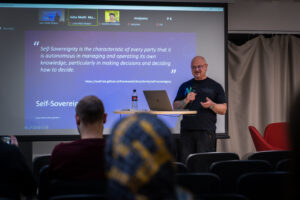
Harri Lainio from OP Lab presented the self-sovereign-identity-concept to seminar audience. The speaker discusses the idea of self-sovereign identity (SSI), a system that allows individuals to control their own digital identity. Argument is that the current mainstream digital identity model is centralized and creates too much power to central parties, SSI promises to handle this problem by democratizing the identity holding process. The speaker discusses various attempts to implement SSI, including the use of decentralized identifiers, and emphasizes the importance of trustworthy digital identity systems that can authenticate entities properly, efficiently, and easily. Suggestion is that with the help of cryptography, SSI can create a more secure and better online environment, where key components of SSI, including verifiable credentials, key-storages, and key-chains plays important role.
Panel discussion – Developing Blockchain and Crypto Projects – Mission Impossible
Facilitated by Laura Vuorenoja, OP Lab
A panel discussion featured four blockchain and crypto experts, who discussed their pain points, successes and lessons learned in the field. The experts were Pekka Kaipio from OP Lab, Sandun Dasanayake from Q4US, Jani Partanen from Joisto, Rainer Koirikivi from Interjektio. They shared their experiences and the challenges they have faced in their projects, which included regulatory issues, complexity in the financial sector, and difficulty fitting blockchain into existing systems.
However, they also noted that blockchain is a convenient and stable way of storing information that would otherwise be difficult to prove valid, and that it can benefit decentralization while preserving data integrity. The panelists agreed that while there are many problems in blockchain development projects, it is a proven technical solution that can solve problems quite nicely.
Sandun Dasanayke mentioned that currently biggest running project, where they are involved, is a project about how parcel information moves between different entities in Europe. Especially, how customs and the operators and the postal operators and then the logistic service providers and all these different entities can share information in a single blockchain at the same time. It preserves the integrity of data, but also it is selectively of data sharing between different parties. This is private enterprise blockchain project, and its not available for the public.
Jani Partanen from Joisto Oy descripted their main product, a document archive solution for really high volumes. Joisto uses blockchain technology for storing the integrity and provenance information of the documents. Blockchain really helps Joisto storing this kind of information.
Rainer Koirikivi from Interjektio presented that they are consulting company who does all kinds of software projects for clients, including blockchain projects since 2017. They believe that blockchain is not always the best solution for every problem, and that it should only be used in cases that require decentralization and integrity. However, they also think that blockchain is a stable and proven technical solution that can solve specific problems nicely which other technologies might not solve. Blockchain provides a convenient way of storing information, that would be difficult to prove to be valid otherwise.
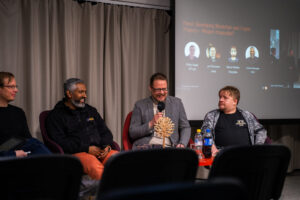
As a challenges it is mentioned, that the complexity of blockchain technology presents challenges in finding skilled experts, who can handle the level of complexity involved. Another mentioned non-technical challenge is, that generally is still assumed that blockchain is equal to bitcoin. This misunderstanding should somehow be fixed.
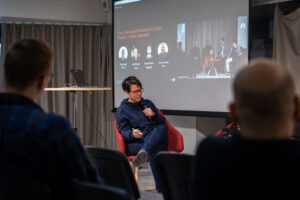
Pekka Kaipio also mentioned about the experimental project in designing a nonlisted sales trading network in compliance with Finnish company law, which states that a company owns its own data. However, they encountered a problem when trying to tokenize shares as an additional law required each paper sale to have a sequence number, making the tokens non-stackable. Proposal for a new law is made to remove the regulation requirement of sequence number. Its noticeable that working with the blockchain can be slow, if it requires laying out new laws.
There are a lot more interesting success stories and lessons learned at the panel recording:
Summary
In conclusion, this seminar on blockchain has shed light on some of the most exciting and innovative technologies being developed in the digital space today. These technologies have the potential to create a more secure, decentralized, and user-centric internet, where individuals have greater control over their personal data and digital identity.
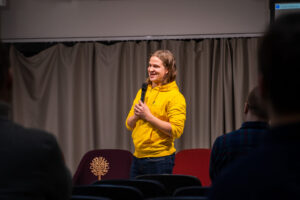
The concept of self-sovereign identity, in particular, has emerged as a promising solution to the challenges of digital identity management. With SSI, users can own and control their own digital identity, instead of relying on centralized identity providers and risking data breaches and identity theft.
However, these technologies also present a range of challenges and threats. Blockchain technology, for instance, is still relatively nascent and faces issues such as scalability, interoperability, and regulatory compliance. The use of SSI also requires new standards, protocols, and legal frameworks to be developed to ensure the protection of user data and privacy.
Additionally, the development of Web3 raises questions about the balance of power and governance in the internet. As Web3 enables the creation of decentralized applications and platforms, it may challenge the dominance of tech giants and create a more democratic and equitable digital space. However, it also raises concerns about the potential for new forms of digital monopolies and the regulation of decentralized systems.
Despite these challenges, the potential opportunities presented by these technologies cannot be overstated. With the rise of Web3 and the development of blockchain-based solutions, we are witnessing the emergence of a new era of the internet. The development of self-sovereign identity solutions can help to create a more secure and user-centric digital space, and open up new possibilities for innovation and collaboration.
It is up to all stakeholders, including policymakers, technologists, businesses, and users, to work together to address the challenges and threats presented by these technologies and ensure that they are used in a responsible and ethical manner. By doing so, for sure we can create a future, where the internet is more decentralized, equitable, and secure for us all.
If I think year 2016 and Slush, and to panel discussion of AI and music creation, I am not doubting anymore, that currently unbelievable features are possible in the future. That includes safe, equitable and secure internet. This doesn’t mean that all previous features of the internet are completely replaced, only improved. Web2 has not removed Web1 and Web3 will not remove Web2, only improve it by building a new layer, a layer of trust.
Resources to start learning:
Free online Web3-masterclass:
https://www.goodcartel.academy/
Chainlink academy:
https://www.chainlink.education/
Self-sovereign identity:
https://www.manning.com/books/self-sovereign-identity
https://findy-network.github.io/
https://www.edx.org/course/identity-in-hyperledger-aries-indy-and-ursa
https://www.w3.org/TR/vc-data-model/
This event is part of Powered by blockchain-project in collaboration with University of Oulu, University of Lapland and Kajaani University of Applied sciences. Project is funded by European Union and European Social Fund. More information about the project can be found from: Tehoa lohkoketjuista -koulutushanke | Vaasan yliopisto (uwasa.fi)


